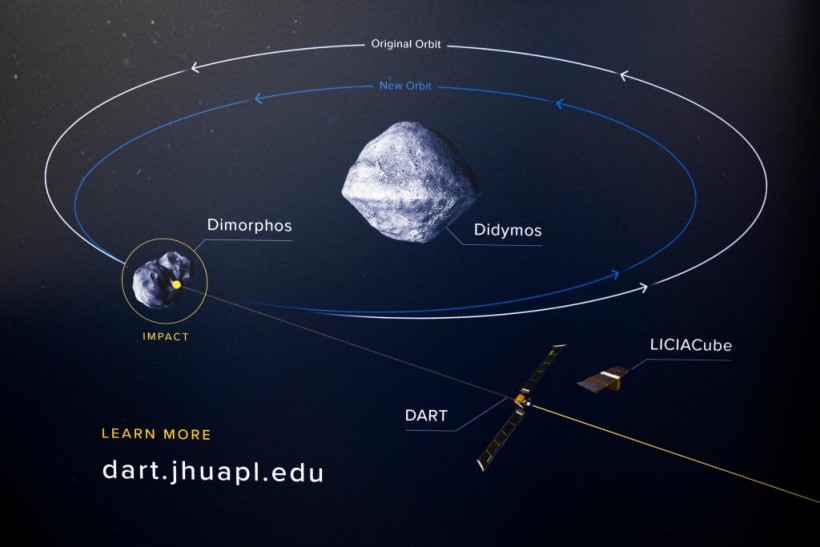Following the successful completion of the Double Asteroid Redirection Test or DART spacecraft of NASA of its first planetary defense test the other night, the small LICIACube or Light Italian Cubesat for Imaging of Asteroids spacecraft captured the very moment in its messy glory.
Mail Online reported that the Italian space agency released a set of images yesterday afternoon that exhibit a before-and-after comparison of an asteroid system called Didymos and a bright burst of debris that surrounds Dimorphos.
NASA's DART spacecraft will crash into an asteroid tonight: Watch live https://t.co/KYV2bhbDcO pic.twitter.com/cxbVAQkR12
— SPACE.com (@SPACEdotcom) September 26, 2022
Essentially, LICIACube is small, containing a pair of optical cameras and weighing about 31 pounds. The tiny spacecraft hitched a ride with DART, which deployed the CubeSat on September 11, and is operated from a mission control center in Turin, Italy.
The science team lead Elisabetta Dotto from Istituto Nazionale di Astrofisica said during a news conference that they're really proud of this recent development.
READ ALSO: NASA's DART Captures First Picture of Didymos Asteroid System [LOOK]

A placard hangs on the wall during the Double Asteroid Redirection Test (DART) Technology Media Workshop Telecon Briefing and tours at the Johns Hopkins Applied Physics Laboratory in Laurel, Maryland, on September 12, 2022, ahead of the September 26th project test mission.
Dimporphos Structure
Dotto explained that the images will help scientists obtain a better insight into the structure of Dimorphos and their composition. The team head also noted that there will be more images released in the days ahead.
In the last captured image, Dimorphos is seen blanketed by hazy bright debris. It is fully covered really by this emission of detritus and dust produced by the impact.
Early this week, according to a related LiveScience report, the LICIACube stayed at a safe distance as DART zoomed into its target although it then carried out a perfectly timed drive-by past the impact area a few minutes after.
The tiny yet mighty craft is currently conducting the first deep-space mission of Italy and will continue beaming images back to Earth.
The DART Mission
The DART mission of NASA slammed into Dimorphos, a tinier space rock circling a more massive asteroid known as Didymos, to find out if it could throw off the orbit of a possible future asteroid that was threatening life on Earth.
Scientists are set to watch the Didymos system closely to find out how much the orbit of Dimorphos actually changed; such results will not come for at least two more months.
Confirmation of the successful planetary defense test of NASA took place seconds after the 14,000 mph collision, sparking applause from the ground team from the Johns Hopkins University Applied Physics Laboratory in Maryland.
On its Twitter post, NASA wrote, "Impact success!" This came after the DART spacecraft collided with a 560-foot steroid approximately 6.7 million miles away from this planet.
'Kinetic Impact'
By striking Dimorphons head-on, the American space agency is hoping that it pushed it into a tinier orbit, scrapping 10 minutes off the time it needs to circle Didymos, which is presently 11 hours and 55 minutes.
The space probe utilized what is known as "kinetic impact," which involves sending a single or more large high-speed spacecraft into the path of a coming near-earth object.
Such a mission, a similar Today UK News report specified, may evoke memories of a Hollywood disaster film like Armageddon, although this is quite real and could save Earth from colliding with a fatal space rock.
Bill Nelson, the NASA Administrator, congratulated the DART team right after the completion of the mission, emphasizing how the successful test could someday save humans.
"We are showing that planetary defense is a global endeavor, and it is very possible to save our planet," Nelson said.
Report about the recent DART test is shown on ABC 7's YouTube video below:
RELATED ARTICLE: NASA James Webb, Hubble Space Telescopes To Attempt Monitoring DART as It Slams Into Dimorphos
Check out more news and information on Space in Science Times.














